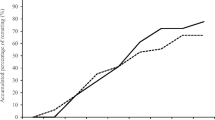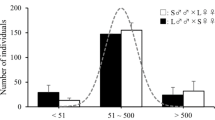Abstract
In many animals, investment in anti-predator traits can affect reproductive success. Conversely, males that invest more resources in mating success may have relatively fewer resources to devote to anti-predator traits, leading to increased predation risk. Although previous studies have reported a trade-off in investment between anti-predator traits and reproductive traits in male animals, few studies have specifically investigated the effects of anti-predator behavior on male reproductive traits. Many animals engage in death-feigning as an anti-predator behavior. Herein, we investigated the relationship between the death-feigning behavior and pre- and post-copulatory reproductive traits of male red flour beetles, Tribolium castaneum. In a previous study, we used artificial selection to establish T. castaneum strains with a genetically longer (L-strain) or shorter (S-strain) duration of death-feigning behavior. In the present study, we compared the attractiveness (a pre-copulatory trait) and paternity success (a post-copulatory trait) between L- and S-strain males. The results showed no significant difference in attractiveness or paternity success between the two strains. The results suggest that death-feigning behavior is not correlated with pre- or post-copulatory reproductive traits in male T. castaneum.



Similar content being viewed by others
References
Andersson M (1994) Monographs in behavior and ecology: sexual selection. Princeton University Press, Princeton
Bernasconi G, Keller L (2001) Female polyandry affects their sons’ reproductive success in the red flour beetle Tribolium castaneum. J Evol Biol 14:186–193
Birkhead TR, Møller AP (1998) Sperm competition and sexual selection. Academic Press, London
Bloch Quazi MC, Boake CRB, Lewis SM (1998) The femoral setiferous glands of Tribolium castaneum males and production of the pheromone 4,8-dimethyldecanal. Entomol Exp Appl 89:313–317
Blum MS, Blum NA (1979) Sexual selection and reproductive competition in insects. Academic Press, New York
Boake CRB (1985) Genetic consequences of mate choice: a quantitative genetic method for testing sexual selection theory. Science 227:1061–1063
Boake CRB, Wade MJ (1984) Populations of the red flour beetle Tribolium castaneum (Coleoptera: Tenebrionidae) differ in their sensitivity to aggregation pheromones. Environ Entomol 13:1182–1185
Breden F, Stoner G (1987) Male predation risk determines female preference in the Trinidad guppy. Nature 329:831–833
Clutton-Brock TH, Parker GA (1992) Potential reproductive rates and the operation of sexual selection. Quart Rev Biol 67:437–456
Eberhard WG (1996) Female control: sexual selection by cryptic female choice. Princeton University Press, Princeton
Edmunds M (1974) Defence in animals. Longman, London
Edvardsson M, Arnqvist G (2000) Copulatory courtship and cryptic female choice in red flour beetles Tribolium castaneum. Proc R Soc B 267:559–563
Fedina TY, Lewis SM (2004) Female influence over offspring paternity in the red flour beetle Tribolium castaneum. Proc R Soc B 271:1393–1399
Fedina TY, Lewis SM (2006) Proximal traits and mechanisms for biasing paternity in the red flour beetle Tribolium castaneum (Coleoptera: Tenebrionidae). Behav Ecol Sociobiol 60:844–853
Fedina TY, Lewis SM (2008) An integrative view of sexual selection in Tribolium flour beetles. Biol Rev 83:151–171
Fromhage L, Jennions M, Kokko H (2016) The evolution of sex roles in mate searching. Evolution 70:617–624
Godin JGJ, McDonough HE (2003) Predator preference for brightly colored males in the guppy: a viability cost for a sexually selected trait. Behav Ecol 14:194–200
Hine E, McGuigan K, Blows MW (2011) Natural selection stops the evolution of male attractiveness. Proc Natl Acad Sci USA 108:3659–3664
Houde AE (1997) Sex, color and mate choice in guppies. Princeton University Press, Princeton
Humphreys RK, Ruxton GD (2018) A review of thanatosis (death-feigning) as an anti-predator behavior. Behav Ecol Sociobiol 72:22
Jivoff P (1997) The relative roles of predation and sperm competition on the duration of the post-copulatory association between the sexes in the blue crab, Callinectes sapidus. Behav Ecol Sociobiol 40:175–185
Lewis SM, Austad SN (1990) Sources of intraspecific variation in sperm precedence in red flour beetles. Am Nat 135:351–359
Lewis SM, Austad SN (1994) Sexual selection in flour beetles: the relationship between sperm precedence and male olfactory attractiveness. Behav Ecol 5:223–224
Lewis SM, Tigreros N, Fedina T, Ming QL (2012) Genetic and nutritional effects on male traits and reproductive performance in Tribolium flour beetles. J Evol Biol 25:438–451
Lima SL (1998) Nonlethal effects in the ecology of predator-prey interactions. Bioscience 48:25–34
Lima SL, Dill LM (1990) Behavioral decisions made under the risk of predation: a review and prospectus. Can J Zool 68:619–640
Magnhagen C (1991) Predation risk as a cost of reproduction. Trends Ecol Evol 6:183–186
Matsumura K, Miyatake T (2018) Responses to relaxed and reverse selection in strains artificially selected for duration of death-feigning behavior in the red flour beetle, Tribolium castaneum. J Ethol 36:161–168
Miyatake T, Katayama K, Takeda Y, Nakashima A, Sugita A, Mizumoto M (2004) Is death-feigning adaptive? Heritable variation in fitness difference of death-feigning behavior. Proc R Soc B 271:2293–2296
Miyatake T, Tabuchi K, Sasaki K, Okada K, Katayama K, Moriya S (2008) Pleiotropic antipredator strategies, fleeing and feigning death, correlated with dopamine levels in Tribolium castaneum. Anim Behav 75:113–121
Nakayama S, Miyatake T (2010a) A behavioral syndrome in the adzuki bean beetle: genetic correlation among death-feigning, activity, and mating behavior. Ethology 116:108–112
Nakayama S, Miyatake T (2010b) Genetic trade-off between abilities to avoid attack and to mate: a cost of tonic immobility. Biol Lett 6:18–20
Nakayama S, Sasaki K, Matsumura K, Lewis Z, Miyatake T (2012) Dopaminergic system as the mechanism underlying personality in a beetle. J Insect Physiol 58:750–755
Nokelainen O, Hegna RH, Reudler JH, Lindstedt C, Mappes J (2012) Trade-off between warning signal efficacy and mating success in the wood tiger moth. Proc R Soc B 279:257–265
Ohno T, Miyatake T (2007) Drop or fly? Negative genetic correlation between death-feigning intensity and flying ability as alternative anti-predator strategies. Proc R Soc B 274:555–560
Parker GA (1970) Sperm competition and its evolutionary consequences in the insects. Biol Rev 45:525–567
Parker GA (1978) Evolution of competitive mate searching. Ann Rev Entomol 23:173–196
R Core Team (2017) R: a language and environment for statistical computing. R Foundation for Statistical Computing, Vienna
Ruxton GD, Allen WL, Sherratt TN, Speed MP (2018) Avoiding attack: the evolutionary ecology of crypsis, warning signals, and mimicry, 2nd edn. Oxford University Press, Oxford
SAS Institute (2015) JMP 12.2.0. SAS Institute, Cary
Schlager G (1960) Sperm precedence in the fertilization of eggs in Tribolium castaneum. Ann Entomol Soc Am 53:557–560
Sharma MD, Hunt J, Hosken DJ (2012) Antagonistic responses to natural and sexual selection and the sex-specific evolution of cuticular hydrocarbons in Drosophila simulans. Evolution 66:665–677
Sih A (1992) Prey uncertainty and the balancing of antipredator and feeding needs. Am Nat 139:1052–1069
Simmons LW (2001) Sperm competition and its evolutionary consequences in the insects. Princeton University Press, Princeton
Sokoloff A, Slatis HM, Stanley J (1960) The black mutation in Tribolium castaneum. J Hered 51:131–135
Suzuki T (1980) 4,8-Dimethyldecanal: the aggregation pheromone of the flour beetle, Tribolium castaneum and T. confusum (Coleoptera: Tenebrionidae). Agric Biol Chem 44:2519–2520
Thornhill R, Alcock J (1983) The evolution of insect mating systems. Harvard University Press, Cambridge
Wilber DH (1989) The influence of sexual selection and predation on the mating and postcopulatory guarding behavior of stone crabs (Xanthidae, Menippe). Behav Ecol Sociobiol 24:445–451
Zuk M, Simmons LW (1997) Reproductive strategies of the crickets (Orthoptera: Gryllidae). In: Crespi BJ (ed) The evolution of mating strategies in insects and arachnids. Cambridge University Press, Cambridge, pp 89–109
Acknowledgement
This work was supported by a Grant-in-Aid for Scientific Research (KAKENHI 26291091 and 18H02510, Ministry of Education, Culture, Sports, Science and Technology, Ministry of Education, Culture, Sports, Science and Technology) to T. M.
Author information
Authors and Affiliations
Corresponding author
Ethics declarations
Conflict of interest
K. Matsumura and T. Miyatake declare that they have no conflict of interest.
Ethical approval
All applicable international, national, and institutional guidelines for the care and use for animals were followed.
Research involving human participants and/or animals
This article does not contain any studies with human participants performed by any of the authors.
Additional information
Publisher's Note
Springer Nature remains neutral with regard to jurisdictional claims in published maps and institutional affiliations.
About this article
Cite this article
Matsumura, K., Miyatake, T. Influence of artificial selection for duration of death feigning on pre- and post-copulatory traits in male Tribolium castaneum. J Ethol 37, 265–270 (2019). https://doi.org/10.1007/s10164-019-00596-4
Received:
Accepted:
Published:
Issue Date:
DOI: https://doi.org/10.1007/s10164-019-00596-4




